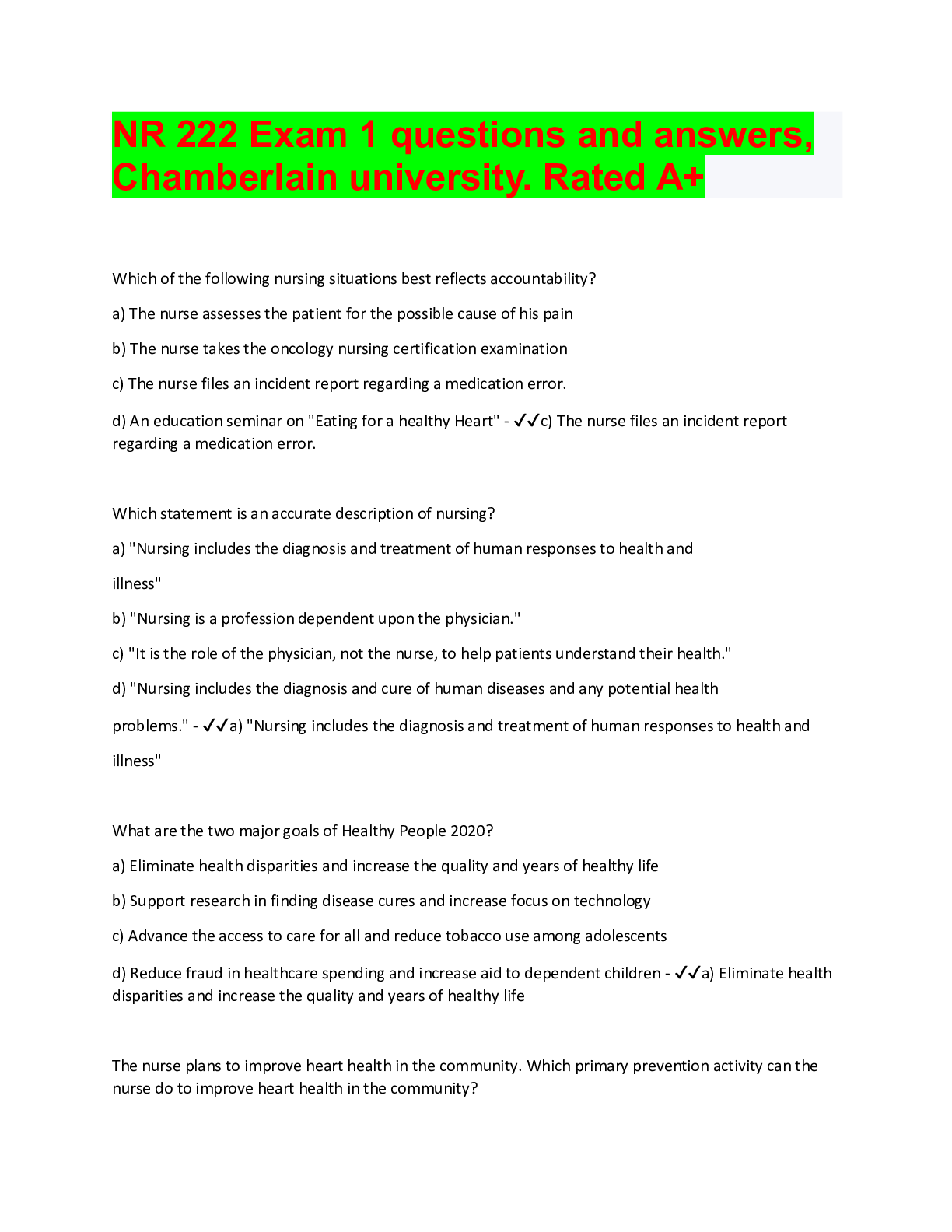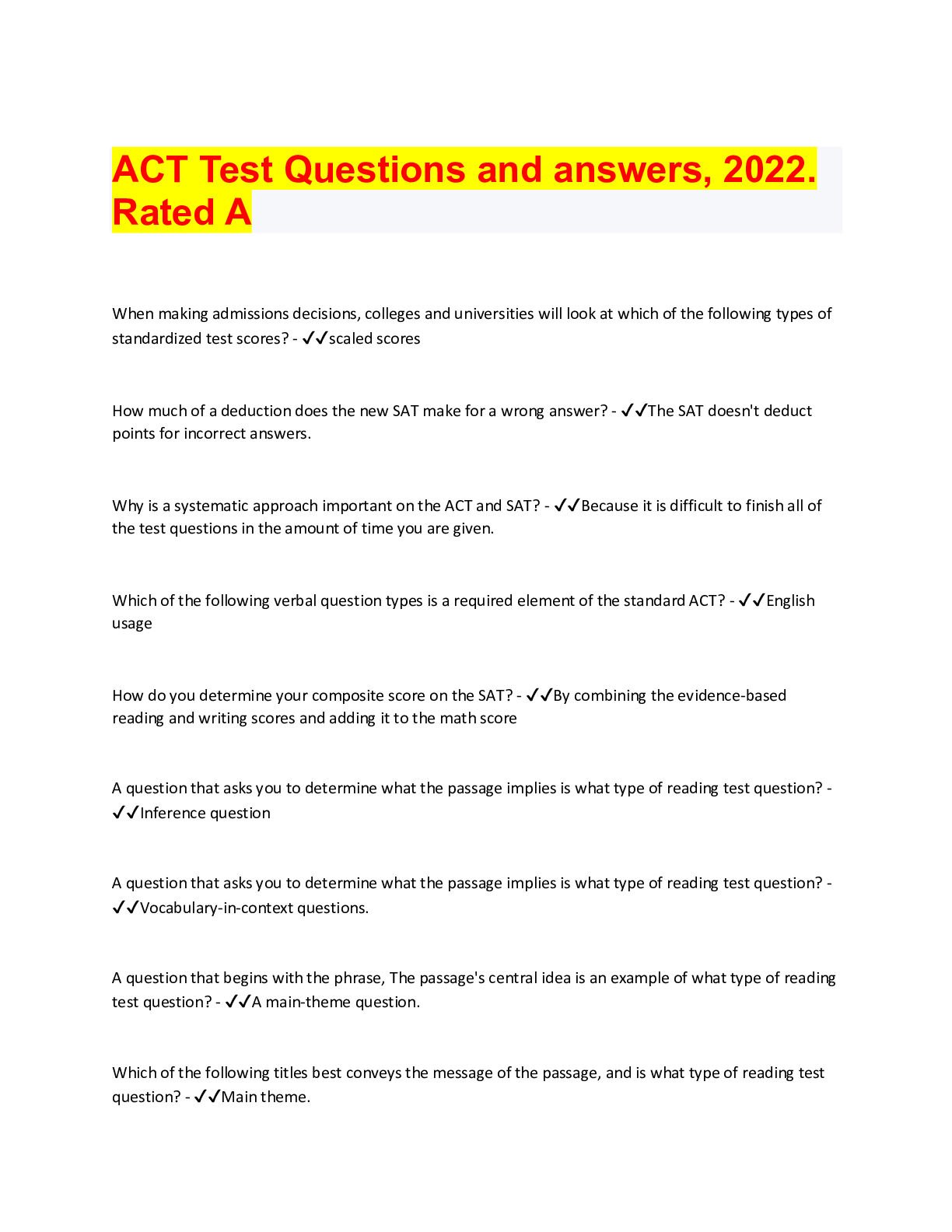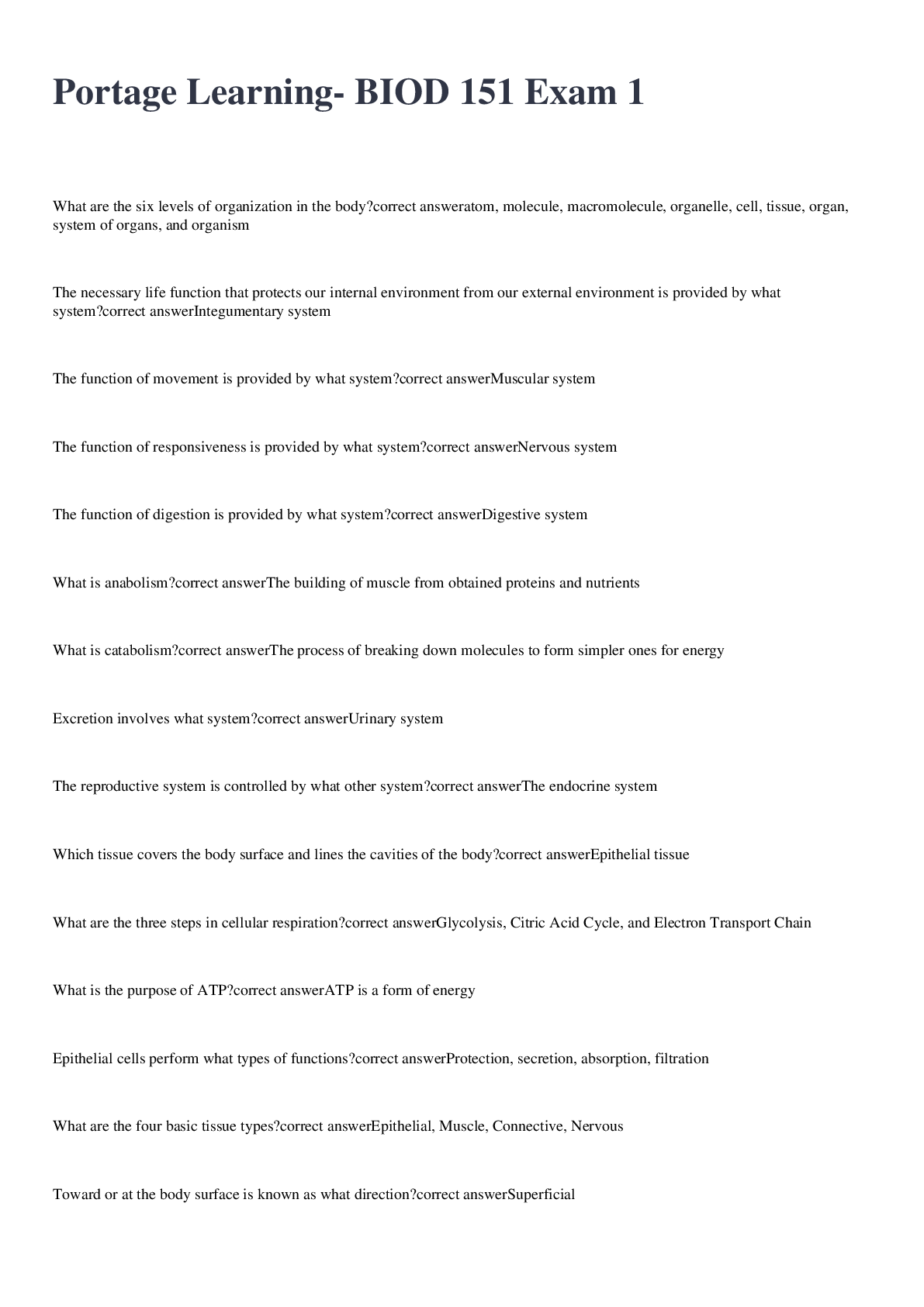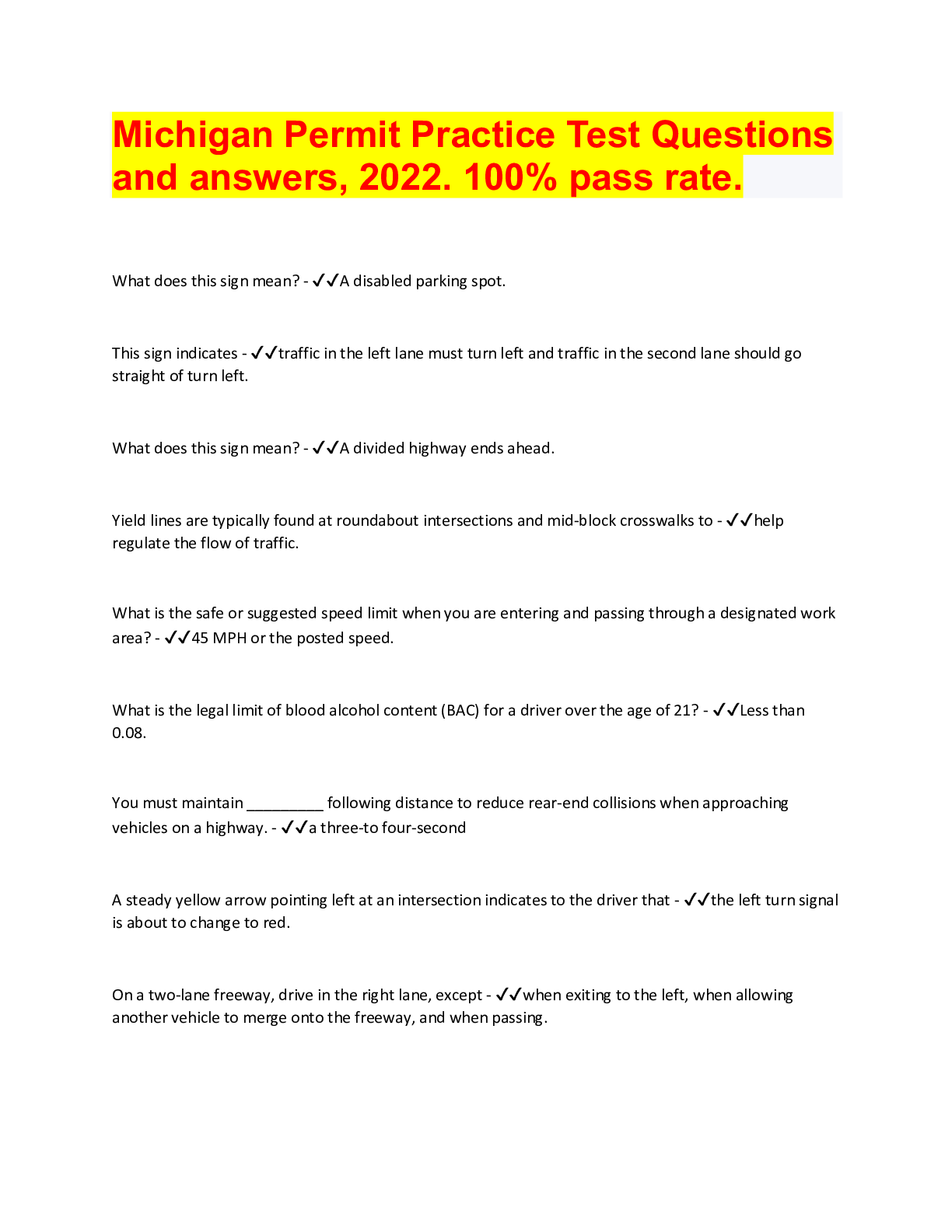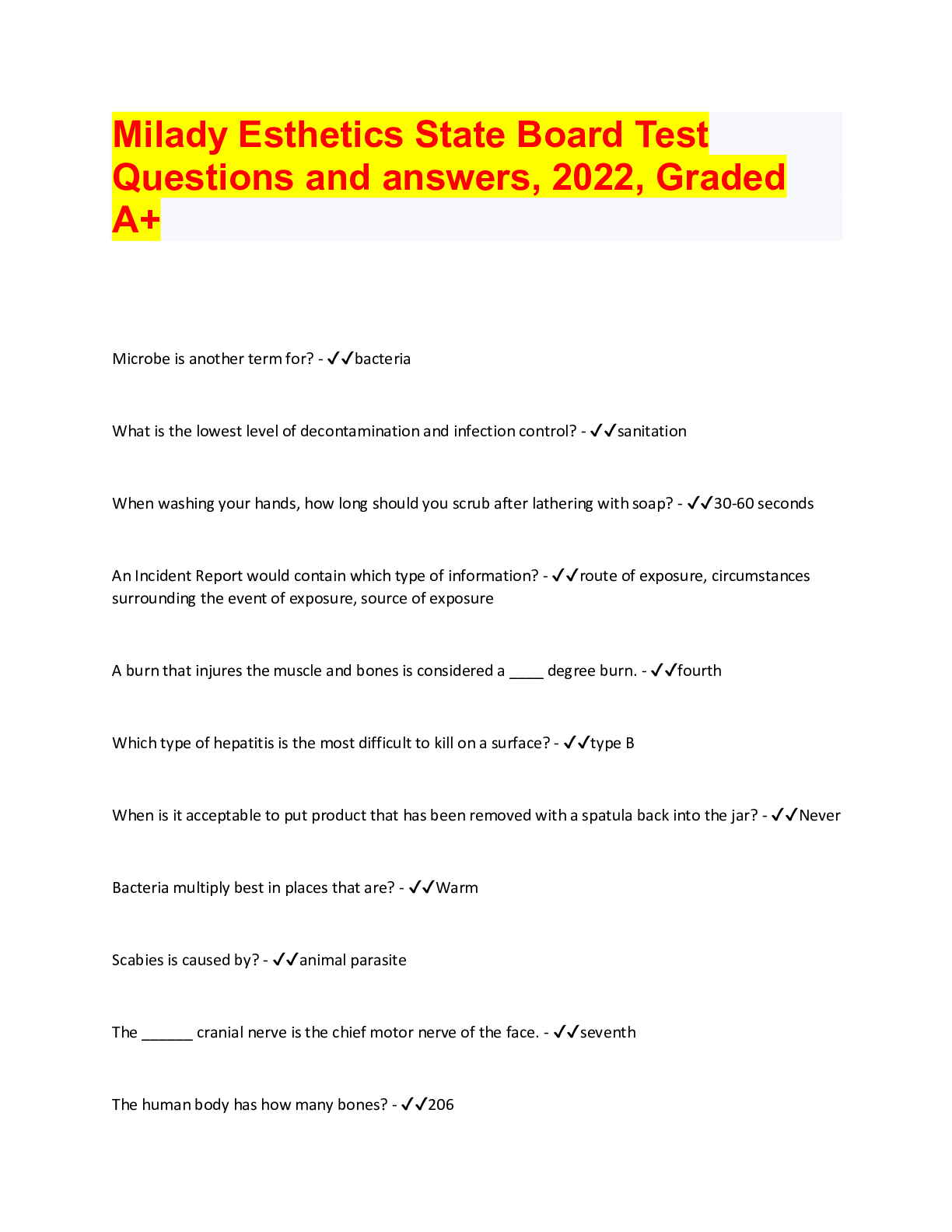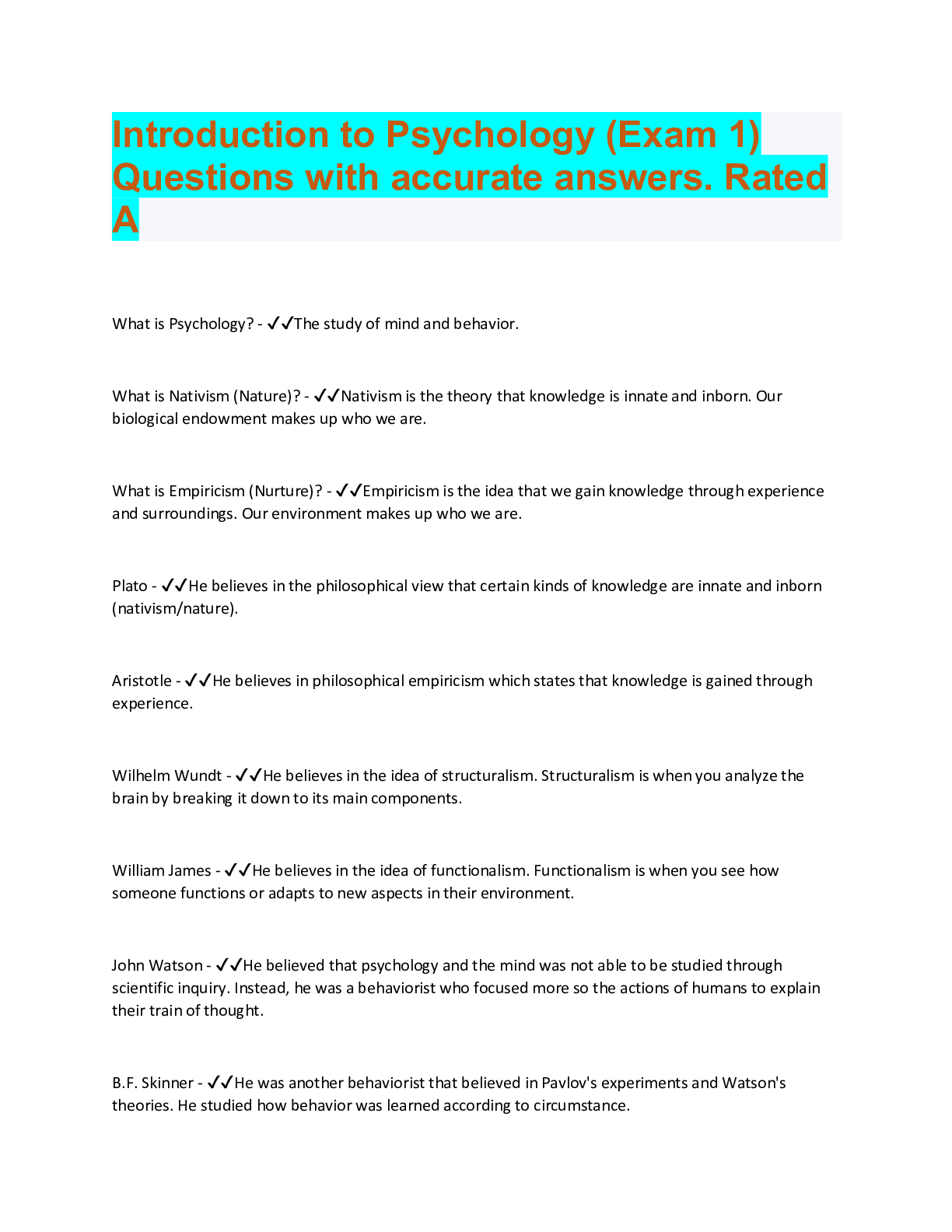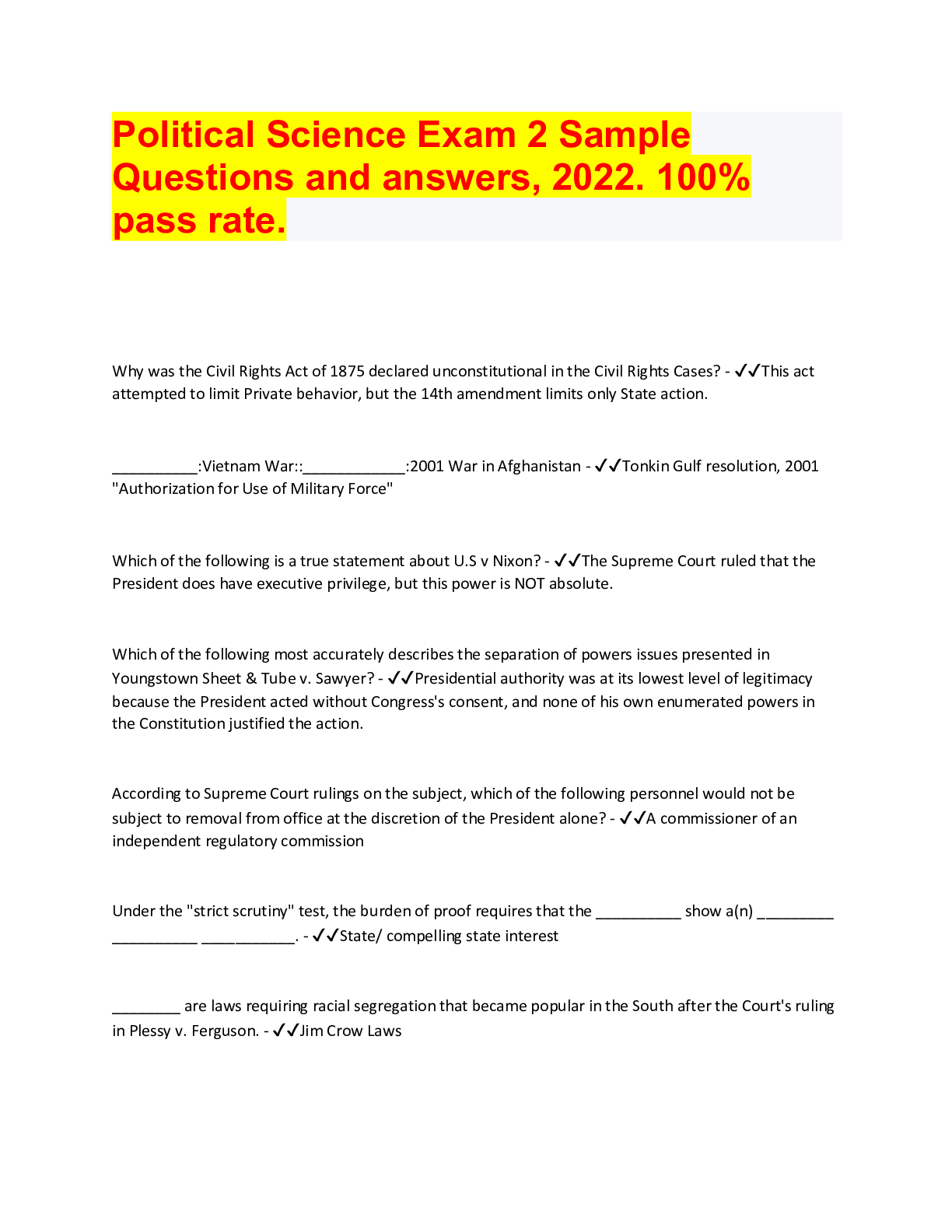*NURSING > QUESTIONS & ANSWERS > EMT-B National Registry Study. Questions and answers, 2022 update, graded A+ (All)
EMT-B National Registry Study. Questions and answers, 2022 update, graded A+
Document Content and Description Below
EMT-B National Registry Study. Questions and answers, 2022 update, graded A+ Stroke is a common cause of brain disorder that is ______ ? - ✔✔Potentially treatable Petit mal seizure typic... ally occurs in children ___ to ___ y/o - ✔✔4-12 years old In some situations the postical state may be characterized by? - ✔✔Hemapharesis or weakness on one side of the body, resembling a stroke. Treat stroke and AMS in children how? - ✔✔The same way you would for an adult. In geriatric patients you should consider a headache as ________ ? - ✔✔Potentially serious The parasympathetic nervous system is responsible for _______ ? - ✔✔Decreased breathing and slowing heart rate. Cephalic presentation is _____ ? - ✔✔Normal position of childbirth where the head enters the pelvis first. Diabetics often suffer from medical complications such as? - ✔✔Heart disease, visual disturbances, renal failure, stroke, ulcers or infections to the feet or toes. The sympathetic nervous system is responsible for ______ ? - ✔✔Speeding up the heart rate and the breathing. Normal blood glucose levels are? - ✔✔80-120 mg/dL Once blood glucose levels reach _______ mg/dL, excess glucose is excreted by the _____ ? - ✔✔200 mg/dL, kidneys A 73 y/o woman was in her backyard gardening when she collapsed to the ground. Her husband told 911 that "she is breathing very fast and will not talk to me." You arrive to find the woman lying on her side in the grass. She is breathing at 7 breaths per minute and her pulse is irregular and very thready. Her lungs also present with crackles upon auscultation As you are taking a blood pressure (88/66) the husband tells you that the woman has been having jaw pain and some weakness for approximately 3 days. What is the most likely cause of this woman's condition and how would you treat her? - ✔✔Cardiogenic shock, assist ventilations and transport. The woman is likely experiencing pump failure and is hypoperfusing. Name the forms of medication (hint- there's 8) - ✔✔1). compressed powder/tablet 2). liquid injection 3). gel 4). suspension (must shake!) 5). gas 6). spray 7). fine powder for inhalation (i.e. MDI's) 8). liquid vaporized fixed dose nebulizer (compressed gas) Routes of medication administration - ✔✔1). sublingual 2). oral (swallowed) 3). inhalation 4). injection Medication name types - ✔✔1). chemical name 2). generic name 3). trade (brand) name 4). official name Epinephrine stimulates four receptors, what are they? - ✔✔Alpha 1 & 2, Beta 1 & 2. These properties make up the sympathetic nervous system. **Beta 1- speeds up heart rate Beta 2 agonist drug causes ______ to dilate. - ✔✔Bronchioles Epinephrine is a ________ ? - ✔✔Vasoconstrictor, bronchodilator, and decreases capillary permeability (to reduce fluid leakage). Nitroglycerin is a __________ ? - ✔✔Vasodilator. (Main side effect: hypotension, causes headache) Define a "drug". - ✔✔A chemical substance used to treat or prevent a disease or condition. Define a "medication". - ✔✔A drug or other substance used as a remedy for illness. The bronchioles are lined _______ and _______. - ✔✔Lined with smooth muscle and mucous membranes. The ____ lung is slightly larger than the ______ lung. - ✔✔Right lung, larger than the left. Brain cells only use ______ for energy. - ✔✔Glucose Trachea posterior wall is _________ ? - ✔✔Made up of muscle therefore not a rigid structure. The first few levels of bronchi are ________ ? - ✔✔Supported by rings of cartilage. The trachea (aka "windpipe") extends from the _____ to the ______. - ✔✔Larynx to the carina. The lower airway extends from the ______ to the ______. - ✔✔Cricoid cartilage to the alveoli of the lungs. Name the possible positions in which to place a patient. - ✔✔1). Supine 2). Prone 3). Fowlers: (sitting up) patient's upper body is at a 45-60 degree angle. 4). Semi-fowlers: patient's upper body is at less than a 45 degree angle. 5). Trendelenberg: patient's legs are elevated higher than the head. 6). Shock position 7). Lateral recumbent: (recovery position) patient is laying on their left or right side. "Ipsilateral" refers to _______ ? - ✔✔The same side. "Contralateral" refers to _______ ? - ✔✔The opposite side. Plantar & palmar refer to _______ ? - ✔✔The sole of the foot and the palm of the hand. Ligaments connect ______ to ______. - ✔✔Bone to bone. Tendons connect ________ to ______. - ✔✔Muscle to bone. The skeletal system serves 4 main functions, what are they? - ✔✔1). Gives the body shape. 2). Provides protection of vital internal organs. 3). Allows for movement. 4). Stores minerals and produces blood cells. Name the 6 main components of the skeletal system. - ✔✔1). Skull 2). Spinal column 3). Thorax 4). Pelvis 5). Upper extremities 6). Lower extremities Name the skeletal components of the skull. - ✔✔Interlocking bones: the occipital, two parietal, two temporal, the frontal. Name the skeletal components of the face. - ✔✔14 bones, 13 of which are immovable & interlocking. Includes: orbits, nasal bones, the maxillae (upper jaw), the zygomatic (cheek) bones, the mandible (lower jaw, strongest bone in the face). What is an intervertebral disc? - ✔✔A fluid pad of tough elastic cartilage between each vertebrae. It acts as a shock absorber & allows for movement of spine. The thorax (aka the chest) is composed of what? - ✔✔The ribs, sternum and thoracic spine. The ____ ribs are ______ arches of bone, which are arranged in _____ and are attached by ______ to the ________. - ✔✔The 24 ribs are semi-flexible arches of bone, which are arranged in 12 pairs and are attached posteriorly by ligaments to the 12 thoracic vertebrae. Name the components of the midline area (abdominal quadrant). - ✔✔-the aorta -pancreas -small intestines -bladder -spine Name the components of the LLQ (left lower quadrant). - ✔✔-colon -small intestines -major artery & vein to the left leg -ureter Name the components of the RLQ. - ✔✔-colon -small intestines -major artery & vein to the right leg -ureter -appendix Name the components of the RUQ. - ✔✔-liver -right kidney -colon -pancreas -gallbladder Name the components of the LUQ. - ✔✔-liver -spleen -left kidney -stomach -colon -pancreas Name the components (inferior & superior) of the sternum. - ✔✔The superior manubrium and the inferior xiphoid process. Describe the attachment of the ribs. - ✔✔-First 7 pair (true ribs) are attached to the sternum by cartilage. -Next 3 pair are attached to the ribs above them with cartilage. -Last 2 pair are not attached to the sternum (false or floating ribs). Name the components of the pelvis. - ✔✔-the sacrum & coccyx of the spine -the iliac crest -pubis -the ischium What is the iliac crest? - ✔✔The part of the pelvis that forms the "wings". What is the ischium? - ✔✔The posterior & inferior portion of the pelvis. What is the pubis? - ✔✔The anterior & inferior portion of the pelvis. What is the acetabulum? - ✔✔The rounded cavity or socket on the external surface of the pelvis that receives the head of the femur. Which bone is the "shin bone" ? - ✔✔The tibia (the medial larger bone of the lower leg). The fibula is the _______ ? - ✔✔The lateral, smaller long bone of the lower leg. Metatarsals are _______ ? - ✔✔The bones that form the arch of the foot. The tarsals are __________ ? - ✔✔The bones of the ankle, hind foot and mid foot. What is the acromion? - ✔✔The lateral triangular projection of the scapula that forms the point of the shoulder. The carpals are ________ ? - ✔✔The 8 bones that form the wrist. The metacarpals are ________ ? - ✔✔The bones of the hand. Name the 6 types of joints and an example of each. - ✔✔1). Ball & socket- shoulder, hip 2). Hinged- elbow, knee, finger 3). Pivot- wrist, head, neck (permits a turning motion) 4). Gliding- bones in hand and feet 5). Saddle- the ankle (permits combination of limited movement) 6). Condyloid- the wrist can move up/down & side/side but not rotate completely. (modified ball & socket type joint that permits motion in 2 directions) Bones have both ______ & ______. - ✔✔Arteries and vessels. The phrenic nerve, which exits the spinal column between the _____ & ______ cervical vertebrae, transmits the electrical impulses that cause the ______ to contract. - ✔✔The phrenic nerve, which exits the spinal column between the 3rd & 5th cervical vertebrae, transmits the electrical impulses that cause the diaphragm to contract. Unlike ______ the _____ have valves to keep blood from backflowing. - ✔✔Unlike the arteries, the veins have valves to help prevent the backflow of blood. Plasma contains large molecules of _______ that keep the water portion of plasma from leaking outside the vessel. - ✔✔Albumin The fetus develops inside a fluid-filled bag-like membrane called the amniotic sac or bag of waters and contains ____ - _____ mL of fluid. - ✔✔500-1,000 mL As the time of delivery nears, certain complications can occur, preeclampsia or pregnancy-induced hypertension, a condition that can develop after the ____ week of gestation. - ✔✔20th week Post delivery care includes drying the baby off and wrapping it in a blanket or towel, as well as placing it on one side with..... ? - ✔✔The head slightly LOWER than the rest of the body. Post delivery care of the umbilical cord is important because? - ✔✔Infection is easily transmitted through the cord to the baby. When transporting a premature infant, keep the temperature of the ambulance at ______. - ✔✔90 to 95 degrees F (32.2-35.9 degrees C) Excessive bleeding occurs when the bleeding exceeds _____ mL. - ✔✔500 mL Infants born before ____ weeks are considered premature. - ✔✔37 weeks A pulmonary embolism is a _____? - ✔✔Blockage of the main artery of the lung (the pulmonary artery) or one of its branches by a substance that has travelled from elsewhere in the body through the bloodstream. This is usually due to embolism of a thrombus (blood clot) from the deep veins in the legs. Symptoms of a pulmonary embolism include? - ✔✔Dyspnea, chest pain on inspiration. Signs of a pulmonary embolism include? - ✔✔Tachycardia, tachypnea, low SpO2, cyanosis. What elements should be evaluated (list in the proper order) when considering the MOI of a car vs. pedestrian accident? - ✔✔1). speed of the vehicle 2). the path the victim took after striking the vehicle 3). how much damage was done to the vehicle 4). apparent injuries What should you suspect from a patient that has just fallen from a significant height? (Hint: something you can't see) - ✔✔Internal injuries What are the two passageways at the end of the pharynx? - ✔✔1). trachea (air) 2). esophagus (food) The larynx has what two parts? - ✔✔1). thyroid cartilage (Adam's apple); anterior/superior to 2). cricoid cartilage; anterior/inferior to What is a common airway obstruction in ALOC patients? - ✔✔The tongue which falls back and occludes airway. What do the submandibular muscles do? - ✔✔Control the tongue. Define "hypoxia". - ✔✔The reduction of oxygen delivery to tissues. Where does the upper airway extend from? - ✔✔The nose, to the mouth, to the most inferior portion of the larynx (cricoid cartilage). Name the vital signs. - ✔✔-respirations (rate, depth, quality) -pulse (rate, rhythm, quality) -skin (CTC- color, temperature, condition) -pupils (PERL?- equality, reactivity, size) -blood pressure -pulse oximetry Noisy Breathing (Sound & Potential Cause) - ✔✔-snoring: tongue partially blocking upper airway -wheezing: constriction of bronchioles in lungs -gurgling: fluid in UPPER airway -stridor/crowing: partial UPPER airway obstruction Name the oxygen cylinders and how many liters are in them at what PSI? - ✔✔All cylinders are at 2,000 PSI -D tank: 350 liters -E tank: 625 liters -M tank: 3,000 liters -G tank 5,300 liters -H tank 6,900 liters Central chemoreceptors are located ________? - ✔✔In the medulla of the brain stem. What muscles are used in breathing? - ✔✔The intercostal and diaphragm muscles. Define "hypopnea". - ✔✔Low volume breathing What is a stoma? - ✔✔A surgical opening What is a tracheostomy? - ✔✔Stoma in the neck What is a laryngectomy? - ✔✔All or partial removal of the larynx. What is the air pressure for both inhalation and exhalation? - ✔✔At inhalation, pressure is negative. At exhalation, the pressure is positive. Healthy people breath on a _________ drive. - ✔✔Hypercarbic drive The respiratory systems stimulus to breath, responds primarily to ________ ? - ✔✔Levels of carbon dioxide in the body. What is the most common cause of cardiac arrest in kids? - ✔✔Hypoxia When is the "Sellick maneuver" (cricoid pressure) used? What is it effective for? How many people must you have to do it? - ✔✔Only in an unresponsive patient not protected by endotracheal tube (ET tube). It is effective in reducing gastric inflation, regurgitation and aspiration of gastric contents. You need 2 EMTs for this. What is the "crossed finger" technique used for? - ✔✔To open mouth of an ALOC or unresponsive patient. A patient with severe bleeding may not show signs of ________ because _________. - ✔✔Cyanosis, because hemoglobin must be present in blood to change its color. When doing a child assessment, remember to _______ before you lay them on their back. - ✔✔Put padding such as a folded towel under their shoulders to keep the airway aligned (they have bigger heads than their body). ______ is an early sign of hypoxia in ________. - ✔✔Bradycardia is an early sign of hypoxia in infants. What is a late sign of hypoxia? - ✔✔Cyanosis In severe hypoxic patients, tachycardia could ________. - ✔✔Lead to dysrhythmias and eventually bradycardia. COPD patients breathe on a _______. - ✔✔Hypoxic drive Oxygenation is the ______ by which the ______ become saturated in oxygen and is the result of ________. - ✔✔Process by which blood and cells become saturated in O2, is the result of respiration. What is the complication with administering oxygen therapy to COPD patients? - ✔✔Their chemoreceptors sense excessive levels of oxygen in the body and send signals to slow or even stop respirations (respiratory arrest or failure could occur). Ventilation is a ______ process. - ✔✔Mechanical process that creates pressure changes in the lungs to draw air in/force it out. The diaphragm is responsible for ______ % of the ventilation effort? - ✔✔60-70% Where is the pleural space/cavity? At what pressure is it at? - ✔✔Between the parietal (rib/outer) pleura and the visceral (lung/inner) pleura space. At negative pressure. What is serous fluid? - ✔✔It is a fluid within the pleural space that acts as a lubricant to reduce friction during the breathing process. This can relax with the tongue in an ALOC patient and cause a non-visible airway obstruction. - ✔✔The epiglottis Name some of the general guidelines of lifting. - ✔✔-have an even number of rescuers -heavy loads carry no more than 1 minute -back locked; don't hyperextend (lean back) -know your limitations Name the 4 principles of "body mechanics". - ✔✔1). keep weight of object as close to body as possible 2). use hip, leg, gluteal muscles to lift 3). "stack" (shoulders, hips, feet) 4). reduce height/distance which object must be moved (lift in stages if needed). What is "lordosis"? - ✔✔Swayback (the butt sticks out) What is "kyphosis"? - ✔✔Slouch back (shoulders [Show More]
Last updated: 1 year ago
Preview 1 out of 48 pages
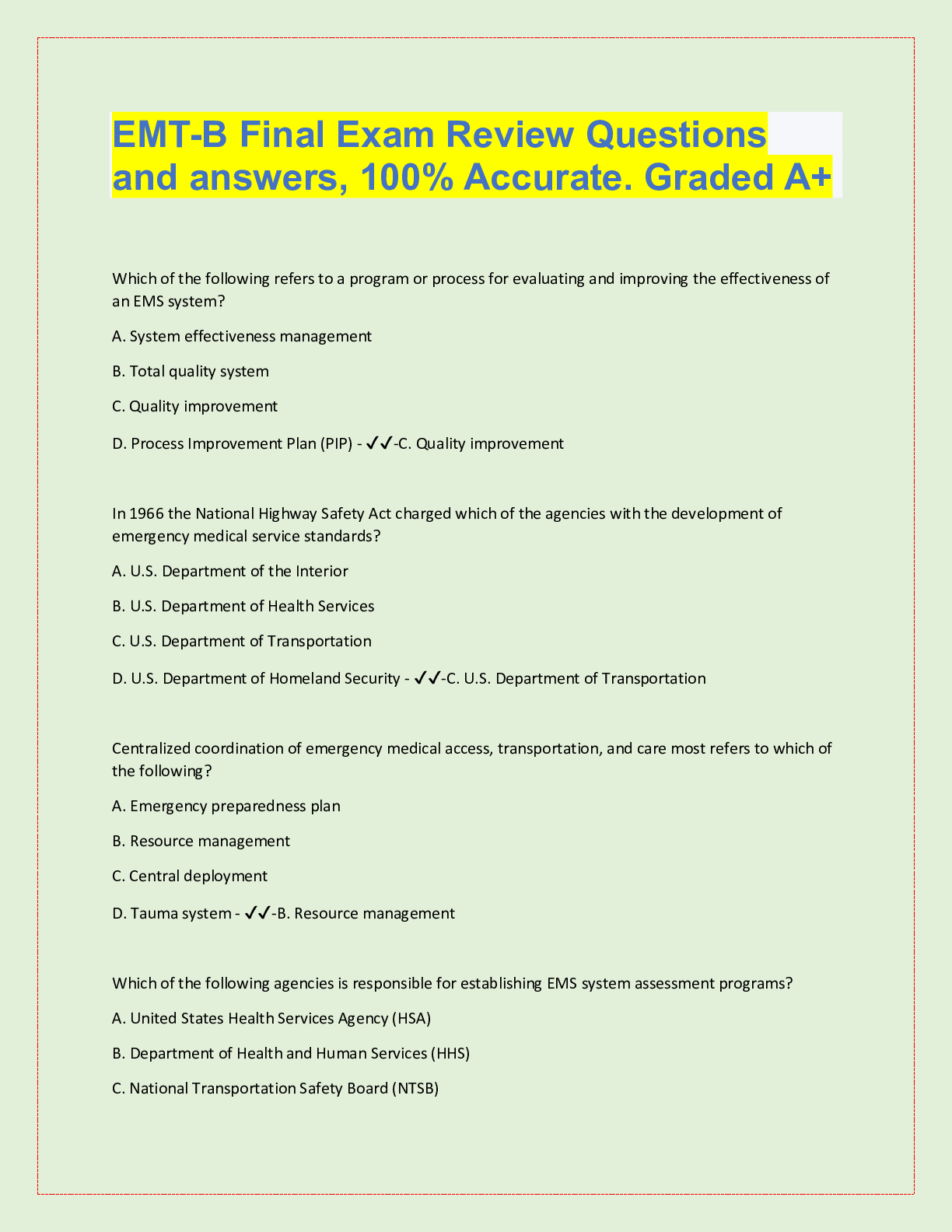
Buy this document to get the full access instantly
Instant Download Access after purchase
Add to cartInstant download
We Accept:

Also available in bundle (2)

THE EMT BUNDLE, QUESTIONS WITH ACCURATE ANSWERS,
Comprises of all EMT documents, Questions and answers, Graded A+
By bundleHub Solution guider 1 year ago
$50
37

All EMT DOCS BUNDLE. LATEST UPDATES, GRADED A+
The EMT bundle , 2022 updates. ALL YOU NEED.
By bundleHub Solution guider 1 year ago
$50
16
Reviews( 0 )
$12.00
Document information
Connected school, study & course
About the document
Uploaded On
Aug 22, 2022
Number of pages
48
Written in
Additional information
This document has been written for:
Uploaded
Aug 22, 2022
Downloads
0
Views
165













